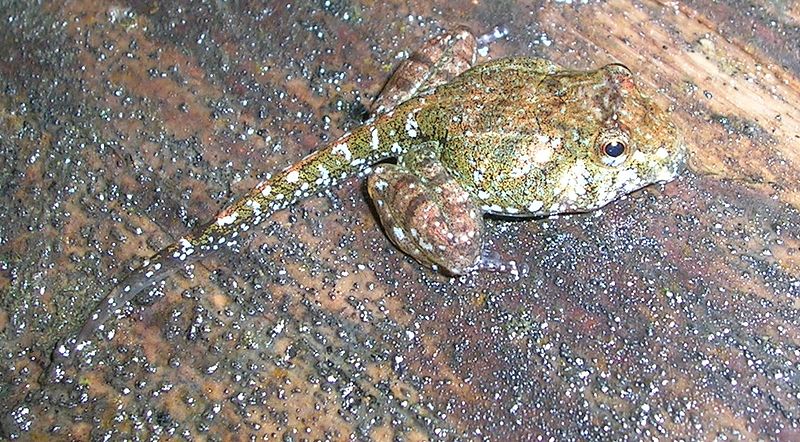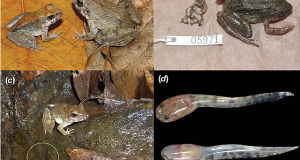 Frogs are well-known for their amazing survival strategies. From behemoths that swallow entire clutches of cobras (please see article below) to tadpoles that develop within their parents’ vocal sacs, frog facts are truly stranger than fiction. Recently, it was discovered that the tadpoles of India’s Brown Leaping Frog, Indirana semipalmata, are unique in both habitat choice and diet (please see photos of this frog and its tadpole).
Frogs are well-known for their amazing survival strategies. From behemoths that swallow entire clutches of cobras (please see article below) to tadpoles that develop within their parents’ vocal sacs, frog facts are truly stranger than fiction. Recently, it was discovered that the tadpoles of India’s Brown Leaping Frog, Indirana semipalmata, are unique in both habitat choice and diet (please see photos of this frog and its tadpole).
A Unique Tadpole Habitat
Biologists at the Agumbe Rainforest Research Station inKarnataka,Indiawere amazed to discover several clutches of Brown Leaping Frog eggs adhering to tree bark. While other frogs are known to lay eggs on land, in such cases the tadpoles are carried by rain or their parents to water to complete their development; Smoky Jungle Frog and certain other tadpoles develop within a moisture-retaining nest.
The Brown Leaping Frog eggs were at least 10 feet from water, and not in a position to be carried there by rain. Also, this was the first time any frog has been observed attaching eggs to tree bark.
A Diet of Tree Bark
 Upon hatching, the tadpoles were observed feeding upon tree bark – the only known example of such a food being consumed by a tadpole. They remained at least 10 feet from any source of water, but were kept hydrated by frequent rains.
Upon hatching, the tadpoles were observed feeding upon tree bark – the only known example of such a food being consumed by a tadpole. They remained at least 10 feet from any source of water, but were kept hydrated by frequent rains.
That is all we know to date concerning this most unusual frog – I eagerly await information on the transformation process and other aspects of its natural history, and will post updates when available.
India’s Unique Endemic Frogs
The genus to which Brown Leaping Frog belongs contains 10 species, all of which are endemic to the Western Ghats region of South India. Several Indirana species deposit their eggs on rocks near rushing streams, and the tadpoles are believed to spend at least some time on land.
Further Reading
http://www.agumberainforest.com/
African Bullfrog Consumes 17 young Cobras
Indirana semipalmata images referenced from wikipedia and originally posted by L. Shyamal
 That Reptile Blog – Reptile, Amphibian and Exotic Pet Care and Information
That Reptile Blog – Reptile, Amphibian and Exotic Pet Care and Information



Hi Frank, Very interesting! It makes me wonder how they stay in the trees without being able to hang on. Maybe sticky bottoms like slugs or lodging in cracks in the bark. Thanks for the news. It’s always enriching.
BTW: we kept the Pacific Tree Frogs. The kitty has brought us a total of 5!!! We have assured her that we don’t need any more and none have been delivered for the past 4 days… When the last 2 showed up 5 and 6 days ago, they got to come into an environment with other frogs and crickets; not as scary. They immediately began eating crickets and the first 3 followed suit. All seem very happy now and great me in the morning by facing me, as if to say – Crickets? I shake one cricket at a time into a bottle cap and deliver them to each frog, so they all get at least 2. We have been harvesting small earthworms for them as well as millers.
I’ve adjusted the bullfrog environment so that there is more land with sphagnum moss over coconut husks. I noticed the other day that some of the moss had been moved around in the morning. It seemed to be used for having a covered area for an underwater peek hole. I placed excess moss around as a supply for her to use and each morning a bit of building has gone on. She is happily taking an earthworm every few days and still spends a lot of time studying their movement before striking. Today she got it on the first strike. She still goes fishing every few days and has ca coated crickets.
6 frogs! And I knew nothing about them before June 1!
All the Best,
Kathy
Hello Kathy, Frank Indiviglio here.
Thanks for the kind words; stream-dwelling tadpoles have sucker-like mouthparts that enable them to cling to rocks in fast currents, these may have a similar adaptation.
Your cat continues to astound me! Field researchers are training dogs to locate terrestrial turtles…your cat may have a future in amphibian research!
Great that the frogs adjusted. You can also provide moths if available around outdoor lights, harvestmen (“daddy longlegs’); they love flies, but best not to collect these; cultures of wingless houseflies are available if you want to try.
Sphagnum is great as a hiding spot but it and perhaps coconut may lower water’s pH (increase acidity) to unsafe levels. Best to pick up a pH test kit at the pet store (dip-strips are simple to use, accurate enough for your purposes). Populations vary as to tolerance, but best to stay above pH 6.2-6.5
Please let me know if you need any further information. Good luck, enjoy and please keep me posted.
Best regards, Frank Indiviglio.
well i did not know that! very bizarre..but then again that nature.
Hello Mike, Frank Indiviglio here.
Yes, this really stretches the bounds of adaptation to “un tadpole-like” habitats, doesn’t it!
Best regards, Frank Indiviglio.